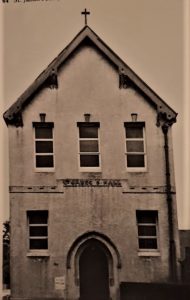Ian Stephenson, Bulletin 2/2022, April 2022

The second site the Society has nominated for a Blue Plaque in Glebe is St James Hall, 153 Bridge Rd Glebe. It is described on Council’s heritage list as ‘a significant part of the history and development of the St James Roman Catholic parish, Glebe and the first school building built for the parish in 1880’.
In 1975 the Aboriginal and Islander Dance Theatre was established here.
The Dictionary of Sydney records that the Aboriginal and Islander Dance Theatre grew out of the Black Theatre and the National Aboriginal and Islander Skills Development Scheme. Developed at first as a course called Careers in Dance, the Aboriginal and Islander Dance Theatre aimed to create opportunities for Indigenous people to have careers in professional dance.
The theatre had direct links with the black power movement in the United States, and was founded by an African-American dancer, Carole Johnson. Johnson had originally come to Australia as part of the Eleo Pomare Dance Company in 1972. Members of the company were struck by the ‘colonial attitudes’ of white Australia. Johnson was asked by the Australia Council to stay on in Australia, to work with Aboriginal people to develop Indigenous theatre. Johnson used her grant from the Australia Council to establish workshops for Aboriginal people in the St James Church Hall, Bridge Rd, Glebe. She later reflected:
In these classes, urban Aboriginal people learned how to create dances to express their social concerns, were introduced to traditional movements, and began to explore ways to fuse traditional Aboriginal movements with modern dance movements.
The students were schooled in traditional dances as well as contemporary styles. The dance theatre successfully launched the careers of many Aboriginal dancers. It also toured nationally and internationally, raising the profile of Aboriginal dance.








There are no comments yet. Please leave yours.